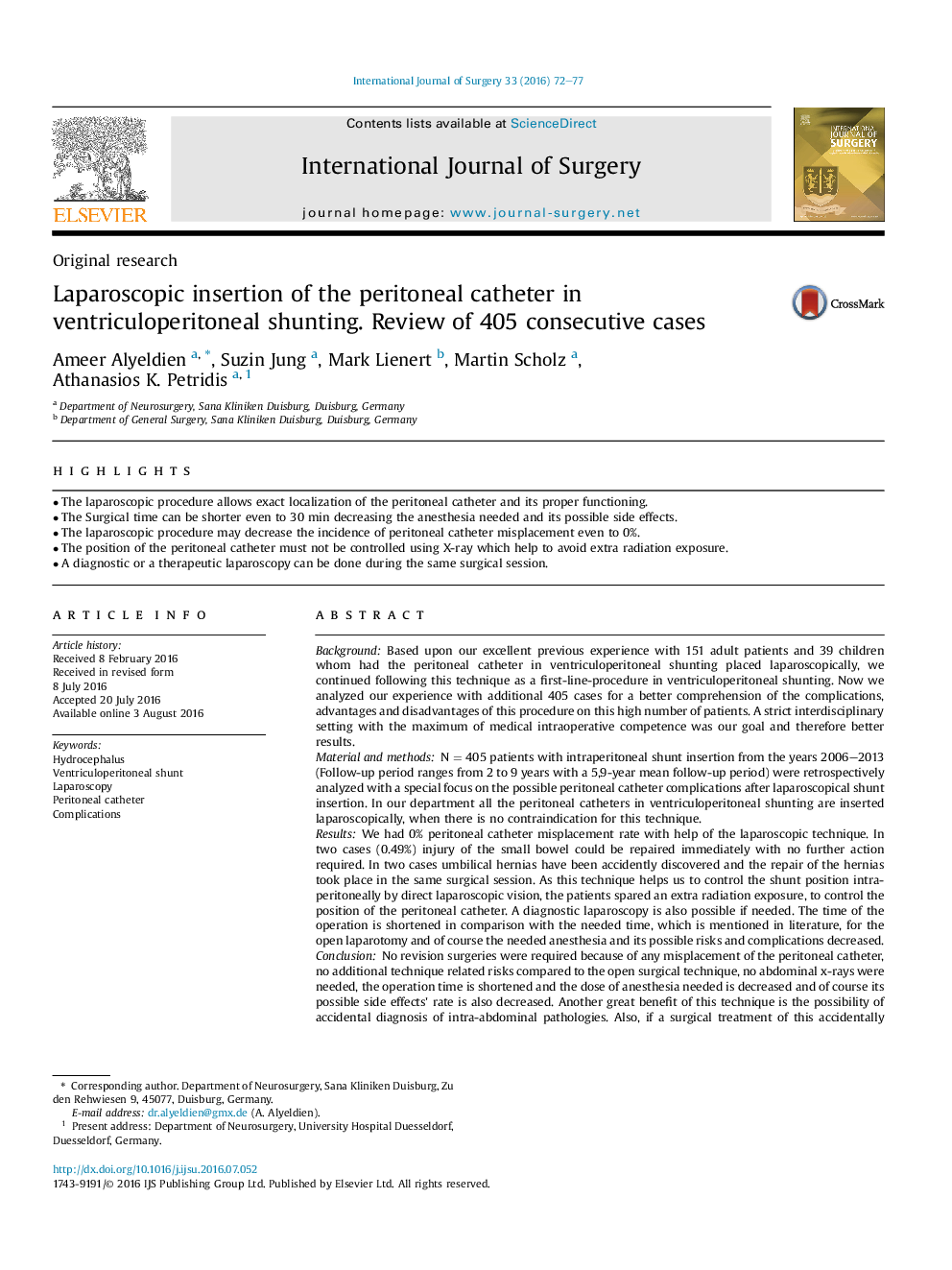| کد مقاله | کد نشریه | سال انتشار | مقاله انگلیسی | نسخه تمام متن |
|---|---|---|---|---|
| 4285305 | 1611953 | 2016 | 6 صفحه PDF | دانلود رایگان |
• The laparoscopic procedure allows exact localization of the peritoneal catheter and its proper functioning.
• The Surgical time can be shorter even to 30 min decreasing the anesthesia needed and its possible side effects.
• The laparoscopic procedure may decrease the incidence of peritoneal catheter misplacement even to 0%.
• The position of the peritoneal catheter must not be controlled using X-ray which help to avoid extra radiation exposure.
• A diagnostic or a therapeutic laparoscopy can be done during the same surgical session.
BackgroundBased upon our excellent previous experience with 151 adult patients and 39 children whom had the peritoneal catheter in ventriculoperitoneal shunting placed laparoscopically, we continued following this technique as a first-line-procedure in ventriculoperitoneal shunting. Now we analyzed our experience with additional 405 cases for a better comprehension of the complications, advantages and disadvantages of this procedure on this high number of patients. A strict interdisciplinary setting with the maximum of medical intraoperative competence was our goal and therefore better results.Material and methodsN = 405 patients with intraperitoneal shunt insertion from the years 2006–2013 (Follow-up period ranges from 2 to 9 years with a 5,9-year mean follow-up period) were retrospectively analyzed with a special focus on the possible peritoneal catheter complications after laparoscopical shunt insertion. In our department all the peritoneal catheters in ventriculoperitoneal shunting are inserted laparoscopically, when there is no contraindication for this technique.ResultsWe had 0% peritoneal catheter misplacement rate with help of the laparoscopic technique. In two cases (0.49%) injury of the small bowel could be repaired immediately with no further action required. In two cases umbilical hernias have been accidently discovered and the repair of the hernias took place in the same surgical session. As this technique helps us to control the shunt position intraperitoneally by direct laparoscopic vision, the patients spared an extra radiation exposure, to control the position of the peritoneal catheter. A diagnostic laparoscopy is also possible if needed. The time of the operation is shortened in comparison with the needed time, which is mentioned in literature, for the open laparotomy and of course the needed anesthesia and its possible risks and complications decreased.ConclusionNo revision surgeries were required because of any misplacement of the peritoneal catheter, no additional technique related risks compared to the open surgical technique, no abdominal x-rays were needed, the operation time is shortened and the dose of anesthesia needed is decreased and of course its possible side effects' rate is also decreased. Another great benefit of this technique is the possibility of accidental diagnosis of intra-abdominal pathologies. Also, if a surgical treatment of this accidentally discovered intra-abdominal pathologies is needed, it can take place in the same surgical session. No prolonged surgery time as the laparoscopic technique is much easier, controllable and fast.
Journal: International Journal of Surgery - Volume 33, Part A, September 2016, Pages 72–77
